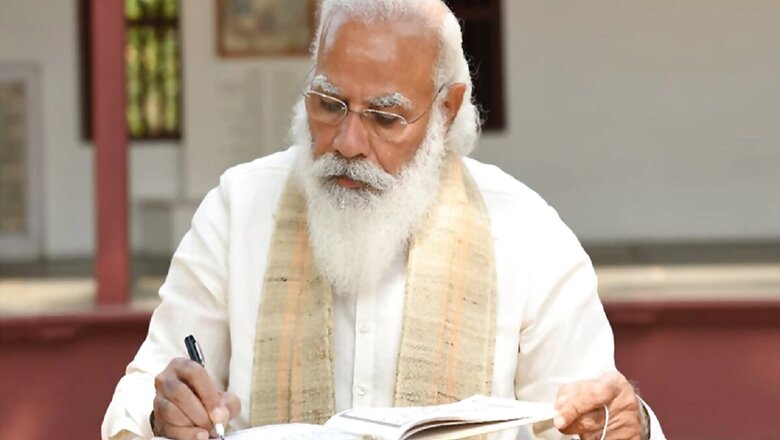
views
Even after 46 years, India has not been able to forget the Emergency. The underground activities during the Emergency had changed the political direction of the country and Narendra Modi, currently occupying the chair of Prime Minister, is the direct outcome of this very shift. During Emergency, he was merely 24. A year after the Emergency was lifted, he had announced that the politics in the country had shifted forever and the days are not far when Jana Sangh will be the most formidable alternative in the country replacing the Congress. At that time, not many people took him seriously.
The year was 1978 and a 24-year-old youth had reached Delhi from Kerala after getting his MA degree. As a student, he had attended the shakhas of the Sangh. He had got the job of a trainee journalist in UNI, a new agency, and with no place to live, he had headed to Keshav Kunj, the Sangh office at Jhandewalan in Delhi. There he met a young man from Gujarat who was four years older than him. He was clean-shaven and attractive. This Malayali youth found something unique in this young man at first sight.
Modi in Delhi in February 1978
At Keshav Kunj, he met Bapurao Moghe, a senior Sangh pracharak who was Akhil Bhartiya Bauddhik Pramukh. The youth from Gujarat was Narendra Modi, Moghe was told. Modi in those days was Vibhag Pracharak in Vadodara, Gujarat. He also looked after the Sangh Shiksha Department’s intellectual wing.
Modi’s Book was Published in January 1978
Before coming to Delhi, in 1978, Modi had already compiled a book called ‘Sangharsh ma Gujarat’, which was an account of the underground activities taking place in Gujarat during the Emergency. On January 14, 1978, on the day of Makar Sankranti, this book was published. Later this book was published in Hindi too; it was titled ‘Aapatkal Mein Gujarat’. The book in Gujarati was unveiled by then chief minister of Gujarat Babubhai Jashbhai Patel.
Modi’s Key Role in Public Agitation
During the 21 month-long Emergency, Modi remained very active, he stayed underground and played a key role in intensifying the public agitation. He was the bridge for communication between several top leaders. These traits of Modi brought him to Delhi. Bapurao Moghe had chosen him to sort the materials collected from all over the world. At that time, all these materials were kept in a huge room in Keshav Kunj, just behind the cloth store room. This room was famous as 20/20 Keshav Kunj.
Senior Sangh Leader Had Assigned Task
The 24-year-old from Kerala, Balashankar, was introduced to Modi. Both of them were assigned their tasks and Modi was to guide the team in sorting the material. Post that, Balashankar was supposed to use them for his research. Balashankar had doubts about whether or not he could complete this work. He had come to Delhi to join the UNI job but he also had to sort the material which weighed 6 tonnes—this included letters, documents, books, advertisement materials used during Emergency to intensify the protests.
ALSO READ | Forced Sterilization, Evictions, Muzzling of Press: Let’s Call Out the Real Fascists Who Imposed Emergency
Balashankar Was Impressed with Modi
At that time, Balashankar had confided in P. Parameswaran, who was the Director of Deendayal Research Institute, about his problem. On the suggestion of Parameswaran, he gave up the idea of joining the UNI and wrote to the General Manager of UNI, Moolchandani, to this effect. After seeing Modi, he was convinced that he would be able to accomplish this task under his direction.
Modi’s Delhi Task: Sort Documents used in Movement against Emergency
The task at hand was arduous. The sarsanghchalak at that time, Professor Rajendra Singh aka Rajju Bhaiya, had decided that the story of Emergency should be recorded and documented. He wanted that the entire story of the agitation against the black Emergency and how the architect of it, Indira Gandhi, was brought to her knees, be documented with inputs from all over the country. He had wanted that the way all political parties were brought on one platform against this Emergency should be documented. It was a result of the combined efforts of the opposition, including the Sangh, that Indira Gandhi was defeated and a non-Congress government of Janata Party came to power in 1977 under the leadership of Morarji Desai.
To work on this plan of Rajju Bhaiya, Bapurao Moghe had called Modi to Delhi, who had already displayed his skills by compiling his own book on Emergency. Moghe was aware of his skill.
Modi Got Down to Work Immediately
Modi started on his work immediately. At 20/20 Keshav Kunj, he got down to sorting the documents—keeping the important and relevant ones aside.
Modi Had Good Rapport with Senior Leaders of Sangh
Balashankar found that apart from Gujarati, Modi was also able to sort the material written in Marathi and Hindi as well because he was well-versed in those languages too. He had also seen and heard him talking to Balasaheb Deoras, who headed the RSS before Rajendra Singh, in Marathi when he had visited Keshav Kunj. Many officials of the Sangh used to visit Keshav Kunj to review the progress of the work. Among them was Dattopant Thengadi who took over the chairmanship of Lok Sangharsh Samiti when Nanaji Deshmukh was arrested during the Emergency. Thengadi was very fond of Modi and had written a foreword for Modi’s book on Emergency in Gujarati. Thengadi had emphasised the role of public agitation the world over and how it had helped India fight the dark era of Emergency. He had also emphasised the need for documentation of public agitations in the country. So, it was natural that when the work of sorting the documents was going on, he was pleased to visit Keshav Kunj and spend some time with Modi.
From 6 Tonnes of Documents to 150 Files
It was decided that Modi will be given two months, February and March, to sort the material, which would then be handed over to Balashankar for documentation. But Modi finished this task in just one-and-a-half months. From the heap of documents weighing 6 tonnes, the final selection weighed roughly a tonne. He created subject-wise files and folders, which had state-wise documents of public agitation. Letters and correspondences, exchanged between leaders, were also part of this documentation. From Morarji Desai to Charan Singh and Atal Bihari Vajpayee and Lal Krishna Advani to the senior pracharaks of the Sangh, the documents pertaining to all these leaders were included in this selection. The number of total folders was around 150.
The Man with Great Ideas
Modi returned to Gujarat after finishing his task before time. But during his stay in Delhi, he struck a good rapport with Balashankar, who felt that this young man is going to make a name for himself in Indian politics. During the course of sorting the documents, Balashankar and Modi used to talk about the political conditions in the country. Balashankar found that Modi was a man with great ideas and his analysis was very sharp.
Modi Predicted Jana Sangh Will Emerge as Powerful Alternative
Modi had clearly stated that following his interactions with different sections of the society during the Emergency, he was convinced that no force could stop the Jana Sangh from becoming a formidable political entity in the days to come. Modi had great expectations from the youth and women of the country and he could see a strong alternative emerging, in the form of Jana Sangh.
ALSO READ | The Emergency of 1975: How Former PM Indira Gandhi Led Country to Chaos, What Followed
Balashankar Was Impressed with Modi
Balashankar was convinced that this pracharak would one day jump headlong into politics. He had even asked Modi if he will join politics or confine himself to Gujarat where he participated in the public agitation during the Emergency. Modi shied away from saying anything about becoming the chief minister of Gujarat and mentioned that whatever role the Sangh wishes him to take up, he will do so. He said that within 10-15 years, Gujarat will have a government headed by the Jana Sangh and if Sangh wants, he will work to strengthen the organisation in the state.
Modi’s Prediction Was Proven Right
Modi’s confidence rubbed off on Balashankar. Balashankar recollected this event when he reached Gujarat in 1995 as a representative of The Indian Express. They met after 17 years. Balashankar had joined The Indian Express via the Organiser, Probe and The Week. But Modi was proven right. In 1990, after running a government with Chimanbhai Patel, Keshubhai Patel was heading the BJP government in 1995 and the architect of the BJP win in the state was Modi. Jana Sangh had morphed into the BJP in 1980.
Modi Laboured his Way to the Top
Balashankar recollected that while Modi was in Delhi in 1978, then Gujarat unit general secretary of Jana Sangh Nathabhai Jhagda had arrived in Delhi and Modi went to receive him and then see him off at the railway station. He also recollected how Modi used to keep everyone amused by cracking jokes. He used to wake up at 4 in the morning, attended Shakha and after breakfast, he would be at his work till seven in the evening. In those days, he used to be surrounded by documents. In the evening, Modi used to visit Karol Bagh to have dosa and coffee and other South Indian delicacies. Modi loved dosa during those days and Udupi and Mysore Café were his favourite places to eat.
Modi Took His Party to the Top
Balashankar had seen all the qualities in Modi that are a prerequisite for a good leader. In 1978, he had seen Modi labouring hard and it was the result of his hard work that Modi was called in by the Sangh to join the BJP in 1986; after that, the party never looked back. He became the chief minister of Gujarat in 2001 and the Prime Minister of India in 2014, heading a majority government of the BJP.
When Book Documenting Emergency Could Not be Published
Balashankar had chosen to work for the Sangh instead of joining UNI. It was unfortunate that the Janata government at the Centre could not last long. Balashankar had to stop his work because the Sangh was apprehensive that Indira Gandhi may return to power again and impose another Emergency, and in that case, the documentation of the public agitation will give the government an idea about the working of the Sangh. So, the idea of documenting the story in the form of a book on Emergency was stopped.
Modi Proved His Own Prophecy Right
But Balashankar has no regrets. He is happy that the young man clad in dhoti-banyaan who used to sort letters at Keshav Kunj, sitting on the floor, and had predicted that over the next 10-15 years, the face of Indian politics would change, is today the Prime Minister of the country. Balashankar has already penned a book called Narendra Modi, Creative Disruptor: The Maker of New India in 2019. This is the same Modi who has made a name for himself in world politics today.
Read all the Latest News, Breaking News and Coronavirus News here.




















Comments
0 comment